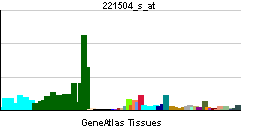ATP6V1H
| ATPase, H+ transporting, lysosomal 50/57kDa, V1 subunit H | |||||||||||
|---|---|---|---|---|---|---|---|---|---|---|---|
| Identifiers | |||||||||||
| Symbols | ATP6V1H ; SFD; CGI-11; MSTP042; SFDalpha; SFDbeta; VMA13 | ||||||||||
| External IDs | Template:OMIM5 Template:MGI HomoloGene: 7139 | ||||||||||
| |||||||||||
| RNA expression pattern | |||||||||||
 | |||||||||||
| More reference expression data | |||||||||||
| Orthologs | |||||||||||
| Template:GNF Ortholog box | |||||||||||
| Species | Human | Mouse | |||||||||
| Entrez | n/a | n/a | |||||||||
| Ensembl | n/a | n/a | |||||||||
| UniProt | n/a | n/a | |||||||||
| RefSeq (mRNA) | n/a | n/a | |||||||||
| RefSeq (protein) | n/a | n/a | |||||||||
| Location (UCSC) | n/a | n/a | |||||||||
| PubMed search | n/a | n/a | |||||||||
ATPase, H+ transporting, lysosomal 50/57kDa, V1 subunit H, also known as ATP6V1H, is a human gene.[1]
This gene encodes a component of vacuolar ATPase (V-ATPase), a multisubunit enzyme that mediates acidification of eukaryotic intracellular organelles. V-ATPase dependent organelle acidification is necessary for such intracellular processes as protein sorting, zymogen activation, receptor-mediated endocytosis, and synaptic vesicle proton gradient generation. V-ATPase is composed of a cytosolic V1 domain and a transmembrane V0 domain. The V1 domain consists of three A and three B subunits, two G subunits plus the C, D, E, F, and H subunits. The V1 domain contains the ATP catalytic site. The V0 domain consists of five different subunits: a, c, c', c", and d. Additional isoforms of many of the V1 and V0 subunit proteins are encoded by multiple genes or alternatively spliced transcript variants. This gene encodes the regulatory H subunit of the V1 domain which is required for catalysis of ATP but not the assembly of V-ATPase. Three alternatively spliced transcript variants encode two isoforms of the H subunit.[1]
References
Further reading
- Stevens TH, Forgac M (1998). "Structure, function and regulation of the vacuolar (H+)-ATPase". Annu. Rev. Cell Dev. Biol. 13: 779–808. doi:10.1146/annurev.cellbio.13.1.779. PMID 9442887.
- Geyer M, Fackler OT, Peterlin BM (2001). "Structure--function relationships in HIV-1 Nef". EMBO Rep. 2 (7): 580–5. doi:10.1093/embo-reports/kve141. PMID 11463741.
- Nishi T, Forgac M (2002). "The vacuolar (H+)-ATPases--nature's most versatile proton pumps". Nat. Rev. Mol. Cell Biol. 3 (2): 94–103. doi:10.1038/nrm729. PMID 11836511.
- Pedersen PL (2003). "Transport ATPases in biological systems and relationship to human disease: a brief overview". J. Bioenerg. Biomembr. 34 (5): 327–32. PMID 12539959.
- Kawasaki-Nishi S, Nishi T, Forgac M (2003). "Proton translocation driven by ATP hydrolysis in V-ATPases". FEBS Lett. 545 (1): 76–85. PMID 12788495.
- Morel N (2004). "Neurotransmitter release: the dark side of the vacuolar-H+ATPase". Biol. Cell. 95 (7): 453–7. PMID 14597263.
- Lu X, Yu H, Liu SH; et al. (1998). "Interactions between HIV1 Nef and vacuolar ATPase facilitate the internalization of CD4". Immunity. 8 (5): 647–56. PMID 9620685.
- Lai CH, Chou CY, Ch'ang LY; et al. (2000). "Identification of novel human genes evolutionarily conserved in Caenorhabditis elegans by comparative proteomics". Genome Res. 10 (5): 703–13. PMID 10810093.
- Hu RM, Han ZG, Song HD; et al. (2000). "Gene expression profiling in the human hypothalamus-pituitary-adrenal axis and full-length cDNA cloning". Proc. Natl. Acad. Sci. U.S.A. 97 (17): 9543–8. doi:10.1073/pnas.160270997. PMID 10931946.
- Mandic R, Fackler OT, Geyer M; et al. (2001). "Negative factor from SIV binds to the catalytic subunit of the V-ATPase to internalize CD4 and to increase viral infectivity". Mol. Biol. Cell. 12 (2): 463–73. PMID 11179428.
- Geyer M, Yu H, Mandic R; et al. (2002). "Subunit H of the V-ATPase binds to the medium chain of adaptor protein complex 2 and connects Nef to the endocytic machinery". J. Biol. Chem. 277 (32): 28521–9. doi:10.1074/jbc.M200522200. PMID 12032142.
- Geyer M, Fackler OT, Peterlin BM (2002). "Subunit H of the V-ATPase involved in endocytosis shows homology to beta-adaptins". Mol. Biol. Cell. 13 (6): 2045–56. doi:02-02-0026 Check
|doi=value (help). PMID 12058068. - Lu M, Vergara S, Zhang L; et al. (2002). "The amino-terminal domain of the E subunit of vacuolar H(+)-ATPase (V-ATPase) interacts with the H subunit and is required for V-ATPase function". J. Biol. Chem. 277 (41): 38409–15. doi:10.1074/jbc.M203521200. PMID 12163484.
- Strausberg RL, Feingold EA, Grouse LH; et al. (2003). "Generation and initial analysis of more than 15,000 full-length human and mouse cDNA sequences". Proc. Natl. Acad. Sci. U.S.A. 99 (26): 16899–903. doi:10.1073/pnas.242603899. PMID 12477932.
- Smith AN, Lovering RC, Futai M; et al. (2003). "Revised nomenclature for mammalian vacuolar-type H+ -ATPase subunit genes". Mol. Cell. 12 (4): 801–3. PMID 14580332.
| This protein-related article is a stub. You can help Wikipedia by expanding it. |